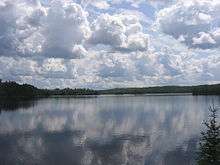International Joint Commission

The International Joint Commission is an independent binational organization established by the United States and Canada under the Boundary Waters Treaty of 1909. Its responsibilities were expanded with the signing of the Great Lakes Water Quality Agreement of 1978 (later amended 1987 and 2012).[1]
Purpose and aims
The purpose of the Commission is to help prevent and resolve disputes about the use and quality of boundary waters and to advise Canada and the United States on questions about water resources. It was consulted for decades during the development of the St. Lawrence Seaway, and the many bridges that have been constructed as international border crossings over the St. Lawrence River and other waterways. The Commission holds public meetings every two years.
Since the late 20th century, it has regularly discussed progress in cleaning up environmental problems of the Great Lakes, as well as issues related to commercial and recreational use of boundary rivers and trans-national rivers. It also sponsors conferences, meetings and round-table discussions, in which members of the public and representatives of community groups and other organizations can take part.
The Commission can alert governments to emerging issues along the border. Its recommendations to the Canada and United States governments are not binding, although they are usually accepted by both governments.[2]
Jurisdictions covered
The Commission has jurisdiction over the Great Lakes–Saint Lawrence River waters and other waters along the border. In the west, the Commission established conditions for dams on the Kootenay, Okanogan, and Columbia rivers, which cross through the states of Washington, Idaho and Montana, and the province of British Columbia. The Commission has also assisted in drafting rules for sharing the St. Mary and Milk rivers in Alberta, Saskatchewan and Montana.
The Commission has been involved in how the Souris River and Red River systems are shared among Saskatchewan, Manitoba and North Dakota. It also sets emergency water levels for the Rainy Lake system, including the Lake of the Woods, which crosses through Minnesota, Manitoba and Northwestern Ontario. Protection of Rainy River water quality is also addressed by the IJC. In the east, the Commission regulates dams and protects the water quality on the St. Croix River, which flows through New Brunswick and Maine.
Organization and boards
The Commission is headed by six commissioners, three from each country. The Commissioners are appointed by the government of Canada and the United States. Commissioners do not represent their governments. The Canadian Commissioners are Gordon Walker (Canadian Chair), Benoît Bouchard, and Richard A. Morgan.[3] The U.S. Commissioners are Lana Pollack (U.S. Chair), Dereth Glance, and Rich Moy.
The Commission has three offices, in Ottawa, Washington, DC, and Windsor, Ontario. The Windsor Great Lakes Regional Office (GLRO) was created under the Great Lakes Water Quality Agreement (GLWQA). It is staffed by a bi-national team of U.S. and Canadian scientists and support staff.
Separate boards are responsible for particular boundary waters issues. When there are special issues, a Task Force is assigned to make a report or recommendations. The various standing bodies are:
- Accredited Officers for the St. Mary - Milk Rivers
- Council of Great Lakes Research Managers
- Great Lakes Science Advisory Board
- Great Lakes Water Quality Board
- Health Professionals Advisory Board
- Great Lakes-St. Lawrence River Task Team
- International Columbia River Board of Control
- International Kootenay Lake Board of Control
- International Lake Superior Board of Control
- International Lake of the Woods Control Board
- Lake of the Woods Basin Water Quality Plan of Study Team
- International Niagara Board of Control
- International Osoyoos Lake Board of Control
- International Rainy Lake Board of Control
- Rainy-Lake of the Woods Watershed Board
- International Red River Board
- International Souris River Board
- International St. Croix River Watershed Board
- International St. Lawrence River Board of Control
Locations
- Great Lakes Regional Office - 100 Ouellette Avenue, Windsor, Ontario (former CIBC Building)
- IJC Canadian Section - 234 Laurier Avenue West, Ottawa, Ontario (former home to Export Development Canada)
- IJC United States Section - 2000 L Street, NW, Washington DC
See also
- Title 22 of the Code of Federal Regulations
- International Boundary and Water Commission (US and Mexico)
- Great Lakes Fishery Commission
References
External links
- International Joint Commission
- Accredited Officers for the St. Mary-Milk Rivers
- International Columbia River Board of Control
- International Great Lakes St. Lawrence River Adaptive Management Task Team
- Great Lakes Science Advisory Board
- Great Lakes Water Quality Board
- Health Professionals Advisory Board
- International Kootenay Lake Board of Control
- International Lake of the Woods Basin Water Quality Plan of Study Team
- International Lake of the Woods Control Board
- International Lake Superior Board of Control
- International Niagara Board of Control
- Osoyoos Lake Board of Control
- International Rainy-Lake of the Woods Watershed Board
- International Red River Board
- International Souris River Board
- International St. Croix Watershed Board
- International Saint Lawrence River Board of Control